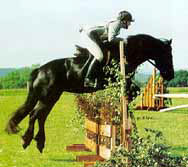Fell Pony
N/A
Fri, 11th April, 2025 - 11:03 pm GMT
Sponsor Ads:

Alternative Name
N/ABasic Info
The Fell breed is distinctive and consistent in appearance, breeding uniformly true to type. Fells are large ponies, standing 13-14 hands (52-56") at the withers although the average is 13.2 hands. They are well muscled but not drafty, suitable for riding and driving. An important conformation feature is well laid back and sloping shoulders to give the comfortable riding action. The shoulders should not be too fine at the withers. The legs must be strong, with plenty of flat bone and the feet round with the characteristic blue horn, and there is feathering around the feet. Most Fells are solid black, though browns, bays and grays are occassionally seen. A small white star and small amounts of white on the hind legs below the fetlock is permissible. Heads are small with a straight profile. Manes and tails are profuse.
Health
N/AHabitat
N/ABehavior
The Fell was selected for a combination of strength, agility and style. The Official Standard of the Fell Pony Society states they should be "constitutionally as hard as iron." Its gaits are smooth and athletic and it is an excellent trotter and jumper. The breed is also known for its good temperament and intelligence.Origin
EnglandHistory
The Fell Pony is a close relative of the Dales Pony and is very similar in looks. However, around 100 years ago Clydesdale blood was introduced to the Dales giving them roughly 4 inches in height and a draftier appearance than the Fells. The original Fell Ponies came from the north of England and are now mainly found on the western side of the Pennines. They derive their name "Fell" from the Norse word for hills. The Fell pony is probably descended from the early Celtic pony and Foreign stock imported in the time of the Romans. This pony was probably widespread over the north of England and was later called the Galloway. They retain the Galloway's characteristic blue horn and a tough and hardy constitution. The Fell Pony has been recognizable as a breed since Roman times in England, when they were employed as draft animals in northern England within local industry and the building of Roman walls. Except for the Exmoor, the Fell Pony is considered the purest of all native British ponies. Before the days of mechanization, the Fell Pony was a "jack-of-all-trades,' shepherding on the fells of England's Lake District, working as a light farm animal and pulling the family carriage on various occasions as well as being a great racing-trotter. For centuries the Fell's major role was as a pack or pannier pony carrying goods of all kinds. Their work was both local and long distance, particularly carrying wool from the Lake District fells to the merchants and lead from mines to the coastal smelting works. The Fell Pony declined alarmingly during the first half of the 20th century, having lost its habitat as a work animal. The Fell Pony Society was founded to promote and conserve the breed. The breed's fortunes improved beginning in the 1950s with the development of riding schools and trekking centers to accomodate the tourist trade. (Trekking is a English term describing the riding of easy moving, comfortable animals). Today, Fells are popular for both riding and for driving. In fact Her Majesty, Queen Elizabeth II owns Fell ponies which are driven by her husband, His Royal Highness Prince Philip, in international competitions (see introductory picture). In 1999, there was an estimated 6,000 Fell Ponies globally, with most of the population found in Britain. The breed is also found in France, Germany, Holland, Australia and North AmericaCommon Foods
grassSponsor Ads:
Pain is inevitable but misery is optional. --Barbara Johnson
Fell Pony
Coded by: BGID® | ALL RIGHTS RESERVED Copyright © 2000-2025
Disclaimer | Privacy | Report Errors / Contact | Credits








 Preparing For China. China is growing their military. China Military Technology - can it keep up with the US?
Preparing For China. China is growing their military. China Military Technology - can it keep up with the US?  versus
versus 

 versus
versus 
 This Thread is about the North Korean Military itself - the kind of army, navy, and air force they have.
This Thread is about the North Korean Military itself - the kind of army, navy, and air force they have. 
 versus
versus 
 versus
versus  versus
versus